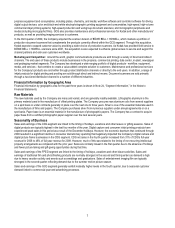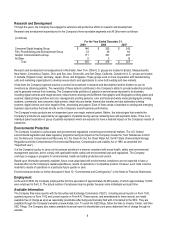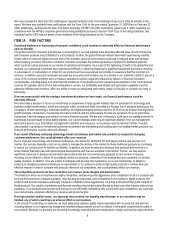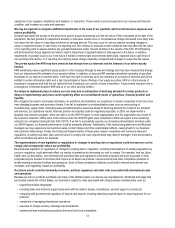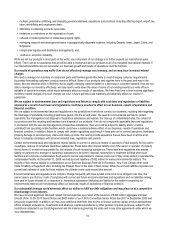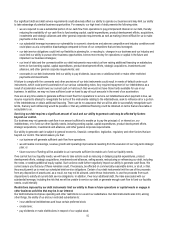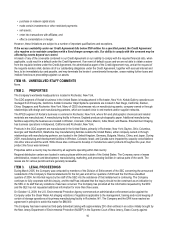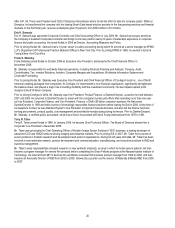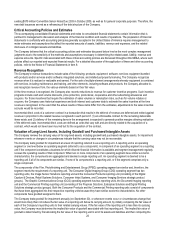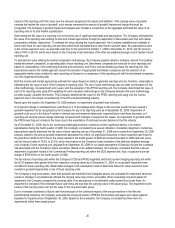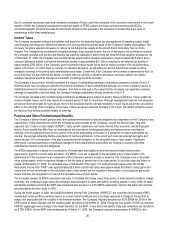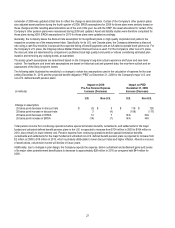Kodak 2009 Annual Report Download - page 19
Download and view the complete annual report
Please find page 19 of the 2009 Kodak annual report below. You can navigate through the pages in the report by either clicking on the pages listed below, or by using the keyword search tool below to find specific information within the annual report. 17
Occidental Chemical Corporation and several other companies that are successors in interest to Diamond Shamrock Corporation.
The NJDEP seeks recovery of all costs associated with the investigation, removal, cleanup and damage to natural resources
occasioned by Diamond Shamrock's disposal of various forms of chemicals in the Passaic River. The damages are alleged to
potentially range "from hundreds of millions to several billions of dollars.” Pursuant to New Jersey's Court Rules, the defendants
were required to identify all other parties which could be subject to permissive joinder in the litigation based on common questions of
law or fact. Third-party complaints seeking contribution from more than 200 entities, which have been identified as potentially
contributing to the contamination in the Passaic, were filed on February 5, 2009. Based on currently available information, the
potential monetary exposure is likely to be in excess of $100,000 but is not expected to be material.
On November 17, 2008, the Company filed a complaint with the U.S. International Trade Commission (“ITC”) against Samsung
Electronics Company Ltd., Samsung Electronics America Inc., and Samsung Telecommunications America, LLC, for infringement of
patents related to digital camera technology. The hearing before the ITC was concluded on October 16, 2009 and an Initial
Determination was issued by the Administrative Law Judge on December 17, 2009 finding Kodak’s asserted patents valid and
infringed. On December 22, 2009, the Company and Samsung agreed to negotiate a definitive agreement to settle the ITC
proceeding and a technology cross license agreement. On January 8, 2010, the Company and Samsung executed a settlement
agreement (“Samsung Settlement”), entered into a technology cross license agreement, and filed joint motions to terminate the
patent infringement proceeding pending before the ITC. These motions were granted on February 2, 2010 and the proceeding was
terminated.
On February 17, 2009 Samsung Electronics Company Ltd. and Samsung Electronics America Inc. filed a complaint with the ITC
against the Company for infringement of certain of their patents alleged to be related to digital camera technology. The hearing
before the ITC was concluded on October 1, 2009. Pursuant to the Samsung Settlement mentioned above, this proceeding was
terminated on February 12, 2010.
On November 17, 2008, the Company commenced a lawsuit in Landgericht Düsseldorf, Germany against Samsung Electronics
GmbH for infringement of a patent related to digital camera technology. Pursuant to the Samsung Settlement mentioned above, this
suit was terminated on February 3, 2010.
On November 17, 2008, the Company filed complaints against Samsung Electronics Company Ltd., Samsung Electronics America
Inc., and Samsung Telecommunications America, LLC in Federal District Court in Rochester, New York, for infringement of patents
related to digital camera technology. Pursuant to the Samsung Settlement mentioned above, this suit was dismissed on February 4,
2010.
On November 17, 2008, the Company filed a complaint with the ITC against LG Electronics Inc., LG Electronics USA Inc. and LG
Electronics MobileComm USA Inc. (referred to collectively as “LG”) for infringement of patents related to digital camera technology.
The hearing before the ITC was concluded on October 16, 2009. On November 30, 2009, the Company and LG entered into an
agreement settling their patent infringement lawsuits against each other (“LG Settlement”) and agreed to file a joint request for
termination of patent infringement proceedings before the ITC. This request was granted and the ITC proceeding was terminated on
January 27, 2010. Separately the Company entered into a technology cross license with LG.
On February 20, 2009 LG Electronics Inc. (Seoul, Korea) filed a complaint with the ITC against the Company for infringement of
certain of their patents alleged to be related to digital camera technology. Pursuant to the LG Settlement mentioned above, this
proceeding was terminated on February 16, 2010.
On November 17, 2008 the Company filed complaints against LG Electronics Inc., LG Electronics USA Inc., and LG Electronics
MobileComm USA, Inc. in Federal District Court in Rochester, New York, for infringement of patents related to digital camera
technology. Pursuant to the LG Settlement mentioned above, this suit was dismissed on December 22, 2009.
On February 20, 2009 LG Electronics Inc. (Seoul, Korea) commenced two actions against the Company in Federal District court in
the Southern District of California for infringement of certain of their patents alleged to be related to digital camera technology.
Pursuant to the LG Settlement mentioned above, these suits were dismissed on December 18, 2009.
On November 20, 2008, Research in Motion Ltd. and Research in Motion Corp. (collectively “RIM”) filed a declaratory judgment
action against the Company in Federal District Court in Dallas, Texas. The suit seeks to invalidate certain Company patents related
to digital camera technology and software object linking, and seeks a determination that RIM handheld devices do not infringe such
patents. On February 17, 2009, the Company filed its answer and counterclaims for infringement of each of these same patents. The
Company intends to vigorously defend itself in this matter.
On January 14, 2010 the Company filed a complaint with the ITC against Apple Inc. and Research in Motion Limited (RIM) for
infringement of patents related to digital camera technology. The Company is seeking a limited exclusion order preventing
importation of infringing devices including IPHONES and camera enabled BLACKBERRY devices. On February 16, 2010, the ITC
ordered that an investigation be instituted to determine whether importation or sale of the accused Apple and RIM devices
constitutes violation of the Tariff Act of 1930.


